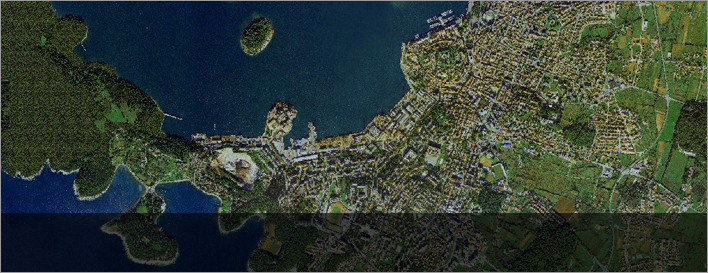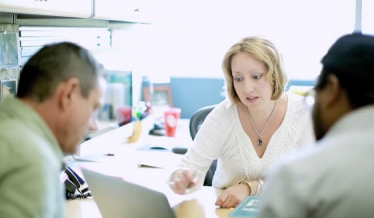
NSF EPSCoR Research: Science-based Solutions for Complex – Wicked – Problems
OK NSF EPSCoR Researchers:
Finding Answers and Practical Solutions to Weather, Water, Land and Infrastructure Issues Facing Oklahomans
NSF EPSCoR researchers are working to develop and test science-based solutions for complex (wicked) problems at the intersection of land use, water availability, and infrastructure in Oklahoma.

The research team's science-based assessments will be coupled with feedback from Oklahoma citizens and systematic engagement with state opinion leaders to develop socially sustainable solutions to emerging problems facing Oklahomans.
The novelty of the project lies in both its design and vision: a social science-led, multi-disciplinary collaboration among social, physical, biological, engineering, and computational scientists from institutions across the state that incorporates the perspectives of competing social narratives. This approach allows the team to better define and develop a science-based understanding of solutions for critical problems resulting from the interactions of humans with the natural and built environment in Oklahoma.
More than forty researchers from Oklahoma State University, University of Oklahoma, University of Tulsa, Southwestern Oklahoma State University, Langston University, East Central University, and Noble Research Institute are working together on the $20 million NSF EPSCoR project, which began on July 1, 2020. Oklahoma State Regents for Higher Education will provide $800,000 annually in matching funds during the five-year award. Click here to learn more about the research team.
A framework informed by theories of public policy learning will be used to invest in science at the intersections of four research focus areas: (1) changing subseasonal to seasonal weather patterns, (2) variable and marginal quality water supplies, (3) shifting terrestrial water and carbon dynamics, and (4) sustainable water and energy infrastructure. Focus area teams will explore technical innovations that have high potential to converge on solutions to wicked problems that cut across the competing social narratives that have impeded collective decisions in the past.
The project’s guiding social dynamics framework allows a systematic and iterative engagement between focus area teams, stakeholders, and the public. Using panel surveys and focus groups, the team’s social dynamics framework will identify interconnections across the four focus areas and measure Oklahomans’ willingness to accept solutions that address critical impacts while accounting for the diverse array of value orientations and economic incentives expressed by stakeholders.
The Social Dynamics Research Framework
Human perceptions and beliefs are at the heart of the most critical challenges facing Oklahoma. They shape behaviors and collective decisions, and therefore our responses to the changing world. Using data from the M-SISNet, the social dynamics team will (a) measure and model perceptions and beliefs underpinning the social narratives that shape debates among the public, opinion leaders, and scientists about the emerging, interconnected, and salient threats to Oklahomans identified in our research focus areas; (b) evaluate how widely shared narratives have undermined collective action to pursue convergent solutions to wicked problems that recognize and address the array of anthropogenic drivers of these threats; and (c) measure social valuation for solutions using willingness-to-pay for potential sustainable solutions.
Coupled with the project’s four interconnected focus areas, the Social Dynamics framework provides the structure and direction of the project. The distinct but interrelated focus areas and the research questions they pursue were selected for this project because they deepen understanding of overlapping natural and human dynamics that drive critical problems facing Oklahoma today. Treated individually as stand-alone problems, they are susceptible to social polarization and policy gridlock. Addressed as an integrated set, these dynamics offer the prospect for revised understandings of problem boundaries and provide potential for informed value tradeoffs across social groups that can enable socially sustainable solutions to address our most pressing problems.
Project Goals
- Strengthen and deepen trans-disciplinary cooperation and capacities in Oklahoma’s research institutions
- Push the boundaries for creative solutions to some of our most vexing societal problems
- Create a visible test-bed for devising and implementing urgently needed approaches and models for integrating science research, outreach, teaching and problem-solving in the face of an increasingly fragmented society
Research Focus Areas
Focus area teams will explore technical innovations that have high potential to converge on solutions to wicked problems that cut across the competing social narratives that have impeded collective decisions in the past. Focus area teams, citizens, and opinion leaders will be engaged throughout the project via multiple multiple modes of inquiry and engagement. Through these convergent methods we will identify scientifically and socially promising redefinitions of problems and Sustainable Solutions for Wicked Problems (SSWPs), culminating in a report that provides a vision and pathway for SSWPs in Oklahoma.
Focus Area 1: Changing Subseasonal to Seasonal (S2S) Weather Patterns
(a) Increase understanding of changing S2S patterns; (b) improve models and prediction capabilities; and (c) develop data for successful management. Click this tab to view more information about this focus area.
Change in both natural and human systems in Oklahoma is being driven by rapidly changing patterns of subseasonal to seasonal (S2S) weather. These fluxuations include shifts in average and extreme precipitation and temperature on scales of 10-90 days. Changes are occurring in the context of competing social narratives of human activities' effect on climate, complicating recognition of and response to changing S2S patterns.
The S2S focus area team will undertake research to (a) better understand the basic processes driving changes in S2S patterns, (b) improve models and predictions of basic S2S process and events; and (c) develop data necessary for managing water, carbon and water cycles, and infrastructure in Oklahoma.
Focus Area 2: Terrestrial Water & Carbon Dynamics (TWCD)
Collect and calibrate data to inform management decisions that will alter ecosystem productivity and carbon storage as well as water yield for agricultural, municipal, industrial, and ecological purposes. Click this tab to view more information about this focus area.
The TWCD focus area is central to the wicked problems facing Oklahoma because of conflicting policy narratives that shape concerns about carbon management and risks associated with landscape management practices (e.g., wildfire risks). At the same time, linkages across the TWCD and other focus areas provide opportunities to engage key stakeholder groups in discussions addressing both problem definition and potentially sustainable solution sets. Land use/carbon cycle issues play this crucial role because of the interactions among terrestrial ecosystems and carbon and water cycling, which are in turn integral components of the other impact domains addressed in this research project.
Focus Area 3: Variable & Marginal Quality Water Supplies (V-MQW)
Develop new engineering technologies and modeling schemes for more effective reuse, and improved understanding of, water treatment efficiencies. Click this tab to view more information about this focus area.
The V-MQW Supplies focus area will address issues surrounding Oklahoma’s water demands, which are projected to increase 600,000 acre-feet per year between 2007-2060. Reliable water supplies are needed to provide for these demands while meeting the state’s goal of capping freshwater use to 2010 levels. However, freshwater supplies are declining due to reservoir sedimentation and groundwater overdraft and are increasingly vulnerable to S2S variability. Concurrently, volumes of oil and gas ‘produced water,’ municipal wastewater, and stormwater are increasing with continued oil and gas development and urbanization. Disposal of produced waters has been correlated with seismicity, potentially impacting infrastructure and resulting in energy production curtailment in some regions. The challenge is finding a mix of solutions that allow OK’s diverse array of MQW to be economically treated for beneficial use to address S2S related water scarcity, waste disposal, and infrastructure risk, while supporting continued energy production and economic growth.
Our researchers hypothesize that the quality of Oklahoma’s MQW can be improved by developing and deploying solutions based on chemical, biotechnological, hydrological, engineering, and sociological principles, with a focus on expanding opportunities for MQW reuse. Reuse of MQW has the potential to provide substantial quantities of water for the industrial, energy, agricultural, and municipal sectors, making communities and economies more resilient to increasing S2S variability. Quantities of MQW are estimated to far exceed consumption in Oklahoma, demonstrating the immense potential of MQW reuse. However, critical uncertainties are associated with 1) the fate of contaminants in MQW (contaminants of emerging concern (CEC), hydrocarbons, etc.) and impacts on public health and industrial, agricultural, and energy sector use; 2) public, industry, and regulatory acceptability of reclaimed water; 3) the energy and carbon footprints and related economic costs associated with conventional and new, innovative treatment systems; and 4) the impacts of S2S variability on the infrastructure and operations of reuse systems.
Focus Area 4: Sustainable Infrastructure (SI)
Develop an aggregated resilience model to characterize the influence of diverse stakeholders’ decision-making behavior on the functions of interdependent infrastructure systems. Click this tab to view more information about this focus area.
Through the development of an aggregated resilience model the SI focus area will advance understanding of the ways in which Oklahoma’s interdependent water and energy infrastructures interact with severe weather, S2S extremes (pluvial events and droughts), carbon cycle patterns (changing land use and increased frequency and scope of wildfires), and water management/reuse patterns (both surface and subsurface, requiring siting and sizing including increases in storage and pipeline capacities). This understanding will facilitate development of an array of solution options for enhancing the state's infrastructure resilience that span the project focus areas (weather, water, and carbon/land use), enabling socially sustainable solutions.
